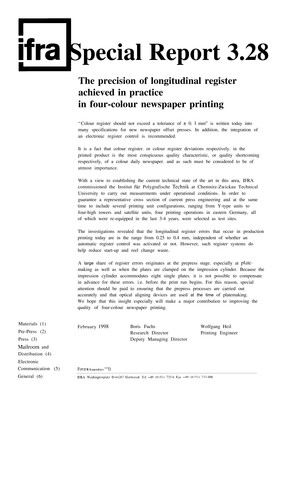The precision of longitudinal register achieved in practice in four-colour newspaper printing
The precision of longitudinal register achieved in practice in four-colour newspaper printing

Price
- For non-members: 150 EUR
- For WAN-IFRA members: Free
Download
Employees of WAN-IFRA member organizations can download the report free of charge here, as a membership benefit:
(Note: You do not need your log-in – just your e-mail address.)
Attention non-members: Reports are available for purchase. Please use the contact information at right.
Summary
"Colour register should not exceed a tolerance of ± 0.1 mm" is written today into many specifications for new newspaper offset presses. In addition, the integration of an electronic register control is recommended. It is a fact that colour register. or colour register deviations respectively. in the printed product is the most conspicuous quality characteristic, or quality shortcoming respectively, of a colour daily newspaper. and as such must be considered to be of utmost importance. With a view to establishing the current technical state of the art in this area, IFRA commissioned the Institut fur Polygrafische Technik at Chemnitz-Zwickau Technical University to carry out measurements under operational conditions. In order to guarantee a representative cross section of current press engineering and at the same time to include several printing unit configurations, ranging from Y-type units to four-high towers and satellite units, four printing operations in eastern Germany, all of which were re-equipped in the last 3-4 years, were selected as test sites. The investigations revealed that the longitudinal register errors that occur in production printing today are in the range from 0.25 to 0.4 mm, independent of whether an automatic register control was activated or not. However, such register systems do help reduce start-up and reel change waste. A large share of register errors originates at the prepress stage. especially at plate-making as well as when the plates are clamped on the impression cylinder. Because the impression cylinder accommodates eight single plates. it is not possible to compensate in advance for these errors. i.e. before the print run begins. For this reason, special attention should be paid to ensuring that the prepress processes are carried out accurately and that optical aligning devices are used at the time of platemaking. We hope that this insight especially will make a major contribution to improving the quality of four-colour newspaper printing.
- Date:
- 1998-02-01
- Language:
- English
- Type:
- IFRA Special Report
- Number:
- 3.28
- Author:
- Fuchs, BorisHeil, Wolfgang
- Cooperating Institutes:
- Institut für polygraphische Technik, TU Chemnitz-Zwickau
Tags
Contact information
WAN-IFRA Research
Phone: +49-6151-733 742
E-Mail: research@wan-ifra.org

